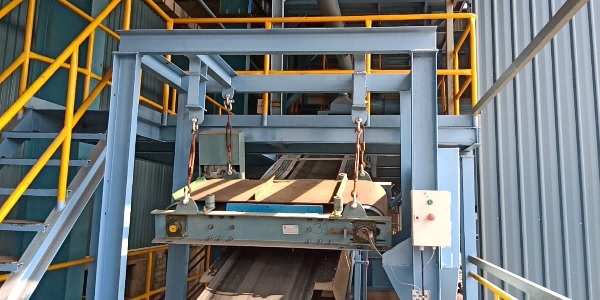Production requires consistency, accuracy, and high dedication to product integrity. A vibrating table is among the lesser-discussed yet extremely efficient solutions to produce superior-quality products. Such specialised equipment becomes more and more necessary in a range of industries, construction and food processing, pharmaceuticals, and metallurgy, where uniform density, de-aeration, and proper settling material are of utmost significance.
A vibration table, or a vibrating table, is utilised to induce controlled vibration on bulk material, bins, or moulds in a bid to promote material compaction as well as eliminate air pockets. Concrete block production, powder settling, and stabilisation of packaging are just a few areas where vibrating tables play an important role in offering product homogeneity and reducing waste upon the manufacture of the product.
Understanding the Role of Vibrating Tables in Manufacturing
A vibrating table is engineered to produce vibrations that help distribute and settle materials uniformly. Vibrating tables are usually mounted with vibratory motors or unbalanced weights that pass on vibrations to the work surface. Their regulated amplitude and frequency enable manufacturers to get very even results.
Reasons why manufacturers rely on vibrating tables:
- Improved Density: Vibration pushes air spaces away and leads to compaction, especially in materials like concrete, powders, and granules.
- Uniformity in Moulds: Items cast in moulds, like tiles or slabs, possess even surface finishes and internal strength.
- Increased Packaging Stability: Dry goods like flour or chemicals settle evenly in containers, minimising spilling or movement during transport.
- Reduced Manual Labour: Vibrating tables automate what could otherwise be uneven, manual processes.
Industrial industries like ceramics, plastics, pharmaceuticals, and metallurgy are greatly helped by the consistent results vibration technology offers.
Major Quality Enhancements Provided by Vibration Tables
Using a vibration table in production provides several concrete improvements to product quality. These include:
Removal of Voids and Air Bubbles
Air in moulds or material layers is evacuated, with the result that products are made stronger and denser.
Uniform Distribution of Material
Uniform spreading and compaction are preferred by vibration, which is required for fine particles and powdered materials.
Minimisation of Material Segregation
Faster settling of heavier particles compared to lighter particles during moulding or filling causes segregation. Vibrating tables reverse this phenomenon.
Improved Finishing Quality
Vibration provides smooth finishes and low surface defects in moulded products.
Increased Strength
Compressed materials have greater wear, moisture, and temperature resistance, resulting in longer product life.
Widespread Application of Vibration Tables in Various Industries
- Construction: Compacting concrete blocks, pavers, and precast components.
- Food Processing: Tapping dry foodstuffs such as grains, nuts, and flour into sealed containers.
- Pharmaceuticals: Obtaining uniform density for powdered medicines and tamping capsules within packaging.
- Metallurgy: De-aeration of castings and powder metallurgy metal powder compaction.
- Chemicals and Plastics: Maintaining powder and pellet uniformity in filling bags or bottles.
Factors to Consider When Choosing a Vibrating Table
The best vibration table to employ depends on a series of process-specific parameters.
Key considerations are:
- Load capacity: Make sure the table can hold your material and moulds’ total weight.
- Mode of vibration: Use linear or circular vibrations depending on the material flow.
- Frequency and amplitude control: Variable controls provide higher accuracy for various materials.
- Designing the table surface: Special dimensions, finishing, and material kinds ensure compatibility in application across industries.
- Compatibility for automation: Consider models that could be incorporated within automated lines.
Inappropriate choice of specifications causes underperformance, higher maintenance costs, or loss of materials.
How Electro Flux Equipments Addresses Quality and Operational Needs
Electro Flux Equipments has gained a solid reputation for providing dependable and programmable vibrating table solutions to various industries. Its vibration tables are engineered to perform consistently and durably, which assists manufacturers in addressing problems such as material segregation, air voids, and uneven density. Every unit comes with high-quality parts and is supported by a one-year service guarantee, which is different from customary industry suppliers.
What distinguishes Electro Flux is its capacity to customise solutions according to particular operating requirements. Heavy materials or light powders, their machinery ensures effective compaction and improved product consistency. Their focus on innovation, quality control, and rapid after-sales support makes them an asset partner for manufacturers seeking to enhance quality and efficiency with vibration technology
Conclusion: Invest in Quality with Vibrating Table Solutions
In the modern era of high-speed manufacturing, uniform quality is no longer a luxury; it’s a requirement. For concrete, powder, or packaged products, a vibration table can be the deciding factor between product consistency, finish, and functionality. By compacting materials effectively, these tables eliminate typical quality defects while saving time.
For companies seeking to incorporate vibration solutions in their process, Electro Flux Equipments has designed professionally vibrating tables that are rugged, made-to-order, and supported by an efficient after-sales support mechanism. Browse their compactors range to improve the quality and reliability of your production line. Also know about gyratory screen separator manufacturers.
